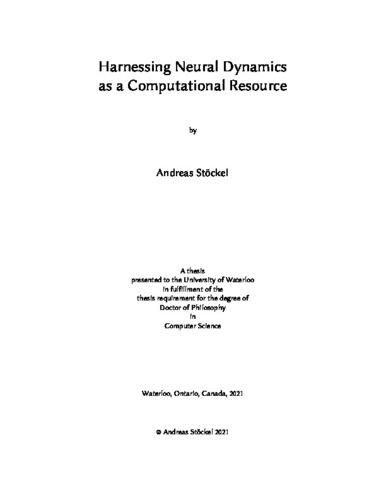| dc.contributor.author | Stöckel, Andreas | |
| dc.date.accessioned | 2022-01-10 13:52:45 (GMT) | |
| dc.date.available | 2022-01-10 13:52:45 (GMT) | |
| dc.date.issued | 2022-01-10 | |
| dc.date.submitted | 2022-01-05 | |
| dc.identifier.uri | http://hdl.handle.net/10012/17850 | |
| dc.description.abstract | Researchers study nervous systems at levels of scale spanning several orders of magnitude, both in terms of time and space. While some parts of the brain are well understood at specific levels of description, there are few overarching theories that systematically bridge low-level mechanism and high-level function. The Neural Engineering Framework (NEF) is an attempt at providing such a theory. The NEF enables researchers to systematically map dynamical systems—corresponding to some hypothesised brain function—onto biologically constrained spiking neural networks. In this thesis, we present several extensions to the NEF that broaden both the range of neural resources that can be harnessed for spatiotemporal computation and the range of available biological constraints. Specifically, we suggest a method for harnessing the dynamics inherent in passive dendritic trees for computation, allowing us to construct single-layer spiking neural networks that, for some functions, achieve substantially lower errors than larger multi-layer networks. Furthermore, we suggest “temporal tuning” as a unifying approach to harnessing temporal resources for computation through time. This allows modellers to directly constrain networks to temporal tuning observed in nature, in ways not previously well-supported by the NEF.
We then explore specific examples of neurally plausible dynamics using these techniques. In particular, we propose a new “information erasure” technique for constructing LTI systems generating temporal bases. Such LTI systems can be used to establish an optimal basis for spatiotemporal computation. We demonstrate how this captures “time cells” that have been observed throughout the brain. As well, we demonstrate the viability of our extensions by constructing an adaptive filter model of the cerebellum that successfully reproduces key features of eyeblink conditioning observed in neurobiological experiments.
Outside the cognitive sciences, our work can help exploit resources available on existing neuromorphic computers, and inform future neuromorphic hardware design. In machine learning, our spatiotemporal NEF populations map cleanly onto the Legendre Memory Unit (LMU), a promising artificial neural network architecture for stream-to-stream processing that outperforms competing approaches. We find that one of our LTI systems derived through “information erasure” may serve as a computationally less expensive alternative to the LTI system commonly used in the LMU. | en |
| dc.language.iso | en | en |
| dc.publisher | University of Waterloo | en |
| dc.relation.uri | https://osf.io/y64xu/ | en |
| dc.relation.uri | github.com/astoeckel/phd_thesis | en |
| dc.subject | computational neuroscience | en |
| dc.subject | conductance based synapses | en |
| dc.subject | multi-compartment LIF neurons | en |
| dc.subject | Legendre delay network | en |
| dc.subject | adaptive filters | en |
| dc.title | Harnessing Neural Dynamics as a Computational Resource | en |
| dc.type | Doctoral Thesis | en |
| dc.pending | false | |
| uws-etd.degree.department | David R. Cheriton School of Computer Science | en |
| uws-etd.degree.discipline | Computer Science | en |
| uws-etd.degree.grantor | University of Waterloo | en |
| uws-etd.degree | Doctor of Philosophy | en |
| uws-etd.embargo.terms | 0 | en |
| uws.contributor.advisor | Eliasmith, Chris | |
| uws.contributor.affiliation1 | Faculty of Mathematics | en |
| uws.published.city | Waterloo | en |
| uws.published.country | Canada | en |
| uws.published.province | Ontario | en |
| uws.typeOfResource | Text | en |
| uws.peerReviewStatus | Unreviewed | en |
| uws.scholarLevel | Graduate | en |

